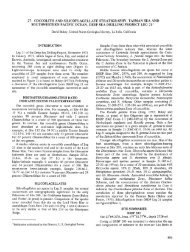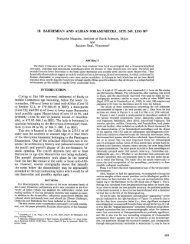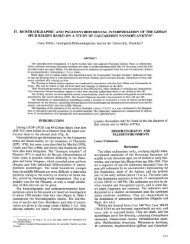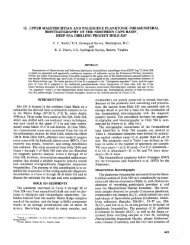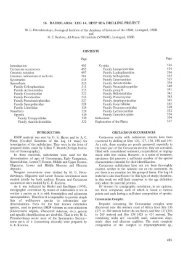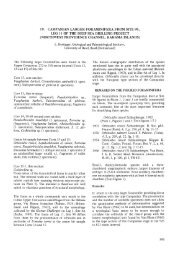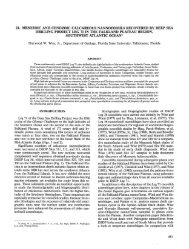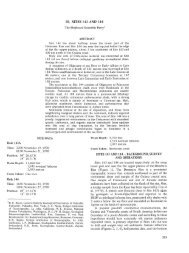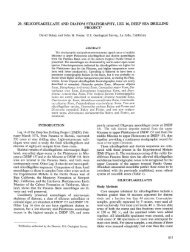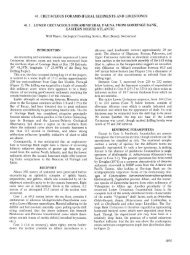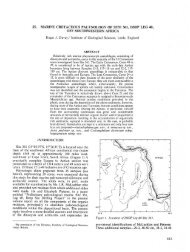17. Planktonic Foraminifera from the Upper Cretaceous of Site 98 ...
17. Planktonic Foraminifera from the Upper Cretaceous of Site 98 ...
17. Planktonic Foraminifera from the Upper Cretaceous of Site 98 ...
Create successful ePaper yourself
Turn your PDF publications into a flip-book with our unique Google optimized e-Paper software.
<strong>17.</strong> PLANKTONIC FORAMINIFERA FROM THE UPPER<br />
CRETACEOUS OF SITE <strong>98</strong>, LEG 11, DSDP<br />
Michele Caron, University <strong>of</strong> Fribourg, Switzerland<br />
INTRODUCTION<br />
<strong>Site</strong> <strong>98</strong> was drilled in <strong>the</strong> Nor<strong>the</strong>ast Providence Channel<br />
in <strong>the</strong> Bahama Islands (lat. 25°22.95'N; long. 77°<br />
18.68'W) in a water depth <strong>of</strong> 2750 meters. The <strong>Upper</strong><br />
<strong>Cretaceous</strong> was penetrated between 272 and 357 meters<br />
below bottom, <strong>of</strong> which 27 meters were cored and<br />
5.1 meters recovered.<br />
The composition <strong>of</strong> <strong>the</strong> planktonic foraminiferal<br />
assemblages <strong>from</strong> Cores 13 through 15 is fairly homogeneous.<br />
The cored intervals correspond roughly to <strong>the</strong><br />
entire Campanian stage. Only at <strong>the</strong> base <strong>of</strong> Core 15 a<br />
few specimens <strong>of</strong> Globotruncana sp. aff. G. renzi and<br />
G. sp. aff. G. area may indicate an older age. Globotruncana<br />
calcarata, present in Core 13, is typical <strong>of</strong> <strong>the</strong><br />
topmost Campanian. The orbitoids in Core 13 and<br />
<strong>from</strong> <strong>the</strong> center bit between Cores 14 and 15 corroborate<br />
this attribution to <strong>the</strong> Campanian (see chapter by<br />
L. Hottinger in this volume).<br />
Globotruncana bulloides, G. stuartiformis, G. linneiana,<br />
G. fornicata, G. leupoldi (= G. stephensoni<br />
Pessagno), and a few G. lapparenti are <strong>the</strong> dominant<br />
and stable components in <strong>the</strong> assemblages. The index<br />
species for <strong>the</strong> Campanian, Globotruncana elevata, and<br />
its numerous transitional forms to G. stuartiformis are<br />
present in Core 15 and disappear in Core 14. Globotruncana<br />
stuartiformis persists to higher levels, where it<br />
is associated with transitional forms to G. subspinosa<br />
and <strong>the</strong> first representatives <strong>of</strong> G. tricarinata. Typical<br />
Globotruncana subspinosa occurs in Core 13. The late<br />
Campanian age <strong>of</strong> this core is indicated by <strong>the</strong> presence<br />
<strong>of</strong> Globotruncana calcarata, G. area, and Globotruncanella<br />
havanensis. In addition, a few representatives <strong>of</strong><br />
Globotruncana ventricosa and G. falsostuarti are<br />
found.<br />
In Cores 15 and 14, numerous specimens <strong>of</strong> a Globotruncana<br />
are present, which could not be identified<br />
with any described species. These specimens share with<br />
Globotruncana stuartiformis <strong>the</strong> shape <strong>of</strong> <strong>the</strong> chambers,<br />
but differ by <strong>the</strong>ir conical test. All transitions between<br />
<strong>the</strong> typically biconvex tests <strong>of</strong> Globotruncana<br />
stuartiformis and specimens with a completely flattened<br />
umbilical side can be observed. A new species,<br />
Globotruncana atlantica n. sp., is introduced to include<br />
<strong>the</strong>se specimens with a spiroconvex test.<br />
REMARKS ON SOME SPECIES<br />
A detailed list <strong>of</strong> <strong>the</strong> planktonic foraminifera and a few<br />
benthonic smaller and larger foraminifera found in <strong>the</strong><br />
<strong>Upper</strong> <strong>Cretaceous</strong> at <strong>Site</strong> <strong>98</strong> is given on <strong>the</strong><br />
distribution-chart. The following remarks are <strong>the</strong>refore<br />
restricted to <strong>the</strong> comments needed for <strong>the</strong> understanding<br />
<strong>of</strong> this chart and to a few ambiguous species.<br />
Globotruncana sp. cf. G. concavata Brotzen<br />
1934 Rotalia concavata Brotzen. Z. Deut. Ver. Palàstinas,<br />
p. 66, pi. 3, fig. b.<br />
1970 Globotruncana concavata (Brotzen), Kuhry.<br />
Lectotype. Revista Espanola de Micropaleontologia,<br />
vol. 2,n. 3, pi. 11, fig. 16-18.<br />
In Samples <strong>98</strong>-15-1, 130 centimeters and <strong>98</strong>-15-1,116<br />
to 119 centimeters, two fragments <strong>of</strong> this species are<br />
found. Excluding <strong>the</strong> possibility <strong>of</strong> contamination, <strong>the</strong><br />
presence <strong>of</strong> Globotruncana concavata would indicate<br />
<strong>the</strong> proximity <strong>of</strong> <strong>the</strong> <strong>Upper</strong> Santonian.<br />
Globotruncana sp. aff. G. fornicata Plummer<br />
(transitional forms between G. renzi and G. fornicata)<br />
The specimens are still close to Globotruncana renzi,<br />
but <strong>the</strong> flexuosity <strong>of</strong> <strong>the</strong> spiral chamber surface is<br />
already well developed.<br />
Globotruncana sp. aff. G. area Cushman<br />
(transitional forms between G. angusticarinata<br />
and G. area)<br />
The two keels are not yet as strongly separated and<br />
vigorous as in typical Globotruncana area.<br />
The presence <strong>of</strong> Globotruncana sp. aff. G. fornicata, G.<br />
sp. aff. G. area, and G. sp. cf. G. concavata point to an<br />
early Campanian to late Santonian age <strong>of</strong> Core 15.<br />
1926<br />
Globotruncana area Cushman<br />
(Plate 2, Figure 2 a-c)<br />
Pulvinulina area Cushman, pi. 3, figs. 1 a-c.<br />
Biconvex test with a well developed inter-rim area<br />
separating <strong>the</strong> two keels. This good index species<br />
occurs in Core 13 toge<strong>the</strong>r with Globotruncana<br />
calcarata.<br />
551
NJ<br />
DISTRIBUTION OF FORAMINIFERA IN THE UPPER C R E TAC EOUS~ SIT E <strong>98</strong><br />
PLANKTONIC<br />
FORAMINIFERA<br />
BENTHONIC<br />
FORAMINIFERA<br />
GL080TRUNCANA<br />
3 1<br />
» 'K a So<br />
i<br />
a ^<br />
IS S |<br />
f 1<br />
-S á<br />
•S °<br />
?<br />
* ° S<br />
V, to 3 v •o<br />
á a S fi •S<br />
«' 2 s "fi<br />
§ I 1<br />
Top<br />
catcher<br />
58-60<br />
u J*<br />
Globotruncana fornicata<br />
G. stuartiformis<br />
assemblage zone<br />
LATE CAMPANIAN<br />
65-67<br />
(PESSAGNO, 1967)<br />
|135-137<br />
icatcher<br />
Center bit between 14 and 15<br />
15 1<br />
15 1<br />
15-22<br />
116-119<br />
TTTT<br />
EARLY CAMPANIAN<br />
15<br />
15<br />
15<br />
1<br />
1<br />
1<br />
130-132<br />
145<br />
bottom<br />
LATE SANTONIAN
Globotruncana atlantica n. sp.<br />
Text-figure 1 a-c (holotype), 2 a-c<br />
(paratype); plate 1, fig. 5 a-c (paratypes).<br />
Description: Test high trochospiral, spiral side strongly<br />
convex, umbilical side flat to slightly convex; equatorial<br />
periphery slightly lobulate, with a single keel. Last<br />
whorl with six to seven chambers which increase slowly<br />
in size. Sutures on spiral side angular to curved in <strong>the</strong><br />
youngest chambers, on <strong>the</strong> umbilical side angular,<br />
forming disjointed chevrons. Umbilicus narrow, shallow,<br />
covered by a spiral system <strong>of</strong> tegilla.<br />
Type locality: Nor<strong>the</strong>ast Providence Channel, Bahamas<br />
Islands; <strong>Site</strong> <strong>98</strong> <strong>of</strong> Leg 11, DSDP, Sample <strong>98</strong>-14-1, 65<br />
to 67 centimeters.<br />
Age <strong>of</strong> type-level: Campanian, lower part <strong>of</strong> Globotruncana<br />
fornicata-G. stuartiformis assemblage-zone<br />
(inPessagno 1967).<br />
Deposition <strong>of</strong> types: Naturhistorisches Museum Basel,<br />
C26628 (holotype), C26629 (paratypes).<br />
Remarks: Globotruncana atlantica n. sp. shares with G.<br />
conica <strong>the</strong> conical outline <strong>of</strong> <strong>the</strong> test in lateral view,<br />
but differs by <strong>the</strong> shape <strong>of</strong> <strong>the</strong> sutures which are<br />
almost always angular on <strong>the</strong> umbilical and <strong>the</strong> spiral<br />
side.<br />
Globotruncana atlantica n. sp. is separated <strong>from</strong> G.<br />
stuarti by <strong>the</strong> shape <strong>of</strong> <strong>the</strong> chambers, which are <strong>of</strong>ten<br />
triangular on <strong>the</strong> spiral side, and by <strong>the</strong> conical outline.<br />
Globotruncana stuartiformis is very close to G atlantica<br />
n. sp. on <strong>the</strong> basis <strong>of</strong> <strong>the</strong> identical shape <strong>of</strong> <strong>the</strong><br />
chambers on <strong>the</strong> spiral and <strong>the</strong> umbilical sides, but<br />
typical representatives <strong>of</strong> <strong>the</strong> two species can be readily<br />
distinguished by <strong>the</strong>ir different aspect in lateral view.<br />
However, transitional forms between <strong>the</strong> two species<br />
are frequently observed. In Text-Figure 3., <strong>the</strong> biconvex<br />
test <strong>of</strong> a typical Globotruncana stuartiformis (b) is<br />
opposed to <strong>the</strong> almost conical test <strong>of</strong> a typical G.<br />
atlantica n. sp. (c).<br />
Globotruncana calcarata Cushman<br />
1927 Globotruncana calcarata Cushman, pi. 23, figs.<br />
lOa-b.<br />
At <strong>the</strong> base <strong>of</strong> Core 13, a few transitional forms point<br />
towards an evolution <strong>of</strong> Globotruncana calcarata <strong>from</strong><br />
j<br />
0,5 mm<br />
i<br />
Figure 1 a-c. Globotruncana atlantica n. sp., holotype; <strong>98</strong>-14-1, 65-67 cm.<br />
0 0,5 mm<br />
i<br />
Figure 2 a-c. Globotruncana atlantica n. sp., paratype; <strong>98</strong>-15-1,130-132cm.<br />
553
G. subspinosa. In <strong>the</strong> same samples, Globotruncana<br />
calcarata is also represented by typical specimens,<br />
which indicate a late Campanian age.<br />
Globotruncana elevata (Brotzen)<br />
(Plate 1, Figure 1)<br />
1934 Rotalia elevata Brotzen, p. 66, pi. 3, fig. c<br />
1955 Globotruncana (Globotruncana) elevata elevata<br />
(Brotzen), Dalbiez, p. 171, text-fig. 9 a-c.<br />
1960 non Globotruncana elevata (Brotzen) = Globotruncana<br />
subspinosa Pessagno, in Pessagno,<br />
p. 336.<br />
1970 Globotruncana elevata (Brotzen), Kuhry, plate<br />
1, fig. 1-3, lectotype.<br />
1970 non Globotruncana elevata (Brotzen) = Globotruncana<br />
elevata stuartiformis Dalbiez, Kuhry,<br />
p. 294.<br />
1970 non Globotruncana elevata (Brotzen) = Globotruncana<br />
subspinosa Pessagno, Kuhry, p. 294.<br />
A recent revision <strong>of</strong> Globotruncana elevata based on<br />
<strong>the</strong> reexamination <strong>of</strong> <strong>the</strong> type-material by Kuhry<br />
(1970) demonstrates that <strong>the</strong> supposed holotype <strong>of</strong> <strong>the</strong><br />
species would be a Globotruncana concavata carinata.<br />
Since Brotzen did not formally designate a holotype in<br />
his original paper, Kuhry selected a lectotype and gave<br />
a good illustration <strong>of</strong> it. This lectotype is a form with a<br />
single keel and a plano-convex outline; <strong>the</strong> chambers<br />
are rounded on <strong>the</strong> spiral side and strongly inflated on<br />
<strong>the</strong> umbilical side. We agree with this judicious<br />
selection <strong>of</strong> a lectotype, but we reject <strong>the</strong> inclusion <strong>of</strong><br />
Globotruncana stuartiformis and G. subspinosa in G.<br />
elevata. Kuhry (and Pessagno, 1967) argue that <strong>the</strong>se<br />
three species are linked by continuous series <strong>of</strong><br />
transitional forms and would <strong>the</strong>refore represent a<br />
single species. Any planktonic foraminiferal species is<br />
linked to o<strong>the</strong>rs by transitional forms, whenever<br />
sufficiently rich and well-preserved assemblages are<br />
examined.<br />
The typical differences between Globotruncana elevata<br />
and G. stuartiformis are: G. stuartiformis is biconvex<br />
and has triangular chambers on <strong>the</strong> spiral side. G.<br />
elevata is plano-convex and has rounded chambers on<br />
<strong>the</strong> spiral side.<br />
(The outlines in lateral view <strong>of</strong> <strong>the</strong> two species are<br />
compares in Text-figure 3 a-b.) Globotruncana elevata<br />
appears already in <strong>the</strong> late Santonian, whereas G.<br />
stuartiformis is restricted to <strong>the</strong> Campanian.<br />
The species Globotruncana subspinosa is characterized<br />
by <strong>the</strong> shape <strong>of</strong> <strong>the</strong> spiral face <strong>of</strong> <strong>the</strong> chambers in <strong>the</strong><br />
youngest whorl. The rounded chambers in Globotruncana<br />
elevata may tend to become triangular as in<br />
G. stuartiformis or to extend backward into a "pseudospine"<br />
as in G. subspinosa. Equally, all transitional<br />
forms can be observed <strong>from</strong> <strong>the</strong> plano-convex outline<br />
<strong>of</strong> Globotruncana elevata to <strong>the</strong> outline <strong>of</strong> G. subspinosa,<br />
and finally to <strong>the</strong> biconvex outline <strong>of</strong> G.<br />
stuartiformis.<br />
The stratigraphic ranges <strong>of</strong> Globotruncana elevata and<br />
G. subspinosa are different. Globotruncana elevata<br />
appears during <strong>the</strong> late Santonion and was phased out<br />
toward <strong>the</strong> middle <strong>of</strong> <strong>the</strong> Campanian at approximately<br />
<strong>the</strong> level at which G. subspinosa makes its appearance.<br />
Globotruncana falsostuarti Sigal<br />
1952 Globotruncana falsostuarti Sigal, p. 43, textfig.<br />
46.<br />
Test biconvex, with a double keel which, in places,<br />
may become fused and have a sinuous shape as in<br />
Globotruncana leupoldi. Fur<strong>the</strong>r investigations may<br />
demonstrate that <strong>the</strong> two species are synonymous. We<br />
would prefer to maintain Globotruncana falsostuarti as<br />
a separate species, since it appears later than G.<br />
Figure 3. Comparison in lateral view <strong>of</strong><br />
a - Globotruncana elevata (Brotzen); <strong>98</strong>-15-1, 148-150 cm.<br />
b - Globotruncana stuartiformis Dalbiez; <strong>98</strong>-15-1, 148-150 cm.<br />
c - Globotruncana atlantica n.sp., holotype; <strong>98</strong>-14-1, 65-67 cm.<br />
554
leupoldi (at <strong>the</strong> top <strong>of</strong> <strong>the</strong> Campanian). Globotruncana<br />
falsostuarti is strictly biconvex, whereas G. leupoldi is<br />
somewhat dissymmetrical.<br />
Globotruncana leupoldi Bolli<br />
(Plate 2, Figure 1 a-b)<br />
1945 Globotruncana leupoldi Bolli, p. 235,1am. 17<br />
(holotype).<br />
1967 Globotruncana stephansoni Pessagno, plate 69,<br />
fig. 1-7; plate 96, fig. 5-6.<br />
1968 Globotruncana leupoldi Bolli, Longoria, lam. 1,<br />
fig. 4-6; lam. 9, fig. 1-4; lam. 19, fig. 2.<br />
This species is <strong>of</strong>ten confused with Globotruncana<br />
fornicata, G, area, and G. falsostuarti, because its<br />
holotype has been designated in a thin section.<br />
Globotruncana leupoldi has <strong>the</strong> same outline as G.<br />
fornicata, but <strong>the</strong> youngest chamber is always singlekeeled.<br />
The spiral surface <strong>of</strong> <strong>the</strong> chambers is always flat<br />
and never flexuous. Globotruncana leupoldi differs<br />
<strong>from</strong> G. area by its narrower inter-rim area. The two<br />
keels, which may be distinctly separated or become<br />
almost fused, form a sinuous line as in Globotruncana<br />
falsostuarti. The umbilical rim is always retracted<br />
below <strong>the</strong> spiral rim level and is always distinctly<br />
weaker; in places, it may be only faintly indicated.<br />
Globotruncana ventricosa White<br />
(Plate 2, Figure 3 a-c)<br />
1928 Globotruncana canaliculata var. ventricosa<br />
White, p. 284, pi. 38, fig. 5 a-c.<br />
This rare but characteristic species is here restricted to<br />
<strong>the</strong> late Campanian.<br />
Globotruncana stuartiformis Dalbiez<br />
(Text-figure 3b; Plate 1, Figure 2 a-c)<br />
1955 Globotruncana (Globotruncana) elevata stuartiformis<br />
Dalbiez, p. 171, text-fig. 10 a-c.<br />
1967 Globotruncana stuartiformis Dalbiez. Pessagno,<br />
pp. 357-59, et pi. 92, fig. 1-3.<br />
1970 Globotruncana elevata (Brotzen), Kuhry, pi. 1,<br />
fig. 4-9.<br />
Reference is made to <strong>the</strong> discussion <strong>of</strong> this species in<br />
<strong>the</strong> paragraph dealing with Globotruncana elevata. in<br />
Globotruncana stuartiformis <strong>the</strong> chambers are typically<br />
triangular on <strong>the</strong> spiral side, whereas <strong>the</strong>y are petaloid<br />
in G. stuarti.<br />
Globotruncana subspinosa Pessagno<br />
(Plate 1, Figures 3,4 a-c)<br />
1960 Globotruncana (Globotruncana) subspinosa<br />
Pessagno, pp. 101-102, pi. 1, figs. 1-9.<br />
Globotruncana subspinosa, a species introduced by<br />
Pessagno in 1960, was placed by <strong>the</strong> same author in<br />
1967 in synonymy with G. elevata. However, <strong>the</strong> very<br />
typical shape <strong>of</strong> <strong>the</strong> chambers on <strong>the</strong> spiral face in<br />
Globotruncana subspinosa and <strong>the</strong> fact that <strong>the</strong>se<br />
forms appear later than G. elevata justify considering<br />
G. subspinosa as a morphologically well individualized<br />
and stratigraphically useful species (see also discussion<br />
<strong>of</strong> G. elevata).<br />
REFERENCES<br />
Dalbiez, F., 1955. The genus Globotruncana in Tunisia.<br />
Micropaleontology. 1, (2), 161, text-figs. 1-10,<br />
charts 1-2.<br />
Hinte van, J. E., 1963. Zur Stratigraphic und Mikropalàontologie<br />
der Oberkreide und des Eozàns des<br />
Krappfeldes (Kàrnten). Austria, Geol. Bundesanst.,<br />
Jahrb., Sonderbd. 8, 1, pis. 1-22, text-figs. 1-15.<br />
Hinte van, J. E., 1965. The type Campanian and its<br />
planktonic foraminifera. /. K. Nederl. Akad.<br />
Wetensch., Proc. ser. B. 68, (1), 8, pis. 1-3, text-figs.<br />
1-9.<br />
Kuhry, B., 1970. Some observations on <strong>the</strong> type<br />
material <strong>of</strong> Globotruncana elevata (Brotzen) and<br />
Globotruncana concavata (Brotzen). Rev. Espan.<br />
Micr. II (3), 291, pi. 1-2, text-figs. 1-6.<br />
Longoria Trevino, J., 1968. Estudio en sección delgada<br />
de algunas especies del genero Globotruncana Cushman<br />
del Santoniano-Maestrichtiano del este de<br />
Mexico. Bol. Asoc. Mexican Geol. Petrol., XX,<br />
(3-12), 41, p. 1-19.<br />
Pessagno, E. A. jr., 1960. Stratigraphy and micropaleontology<br />
<strong>of</strong> <strong>the</strong> <strong>Cretaceous</strong> and lower Tertiary <strong>of</strong><br />
Puerto Rico. Micropaleontology. 6, (1), 87, pis. 1-5,<br />
text-figs. 1-2, charts 1-3.<br />
Pessagno, E. A. jr., 1962. The <strong>Upper</strong> <strong>Cretaceous</strong><br />
stratigraphy and micropaleontology <strong>of</strong> <strong>the</strong> Ponce-<br />
Coamo area, south-central Puerto Rico. Micropaleontology.<br />
8, (3), 349, pis. 1-6.<br />
Pessagno, E. A. jr., 1967. <strong>Upper</strong> <strong>Cretaceous</strong> planktonic<br />
foraminifera <strong>from</strong> <strong>the</strong> Western Gulf Coastal Plain.<br />
Paleont. Am. V, (37) 1, text-figs. 1-63, pis. 48-101.<br />
Sigal, J., 1952. Apercu stratigraphique sur la micropaléontologie<br />
du Crétacé. XIX Congr. Geol. Intern.<br />
Monographies régionales, sér. 1, n. 26, 1, figs. 1-46.<br />
555
PLATE 1<br />
Figure 1<br />
Globotruncana elevata Brotzen; <strong>98</strong>-13, core catcher;<br />
X130.<br />
Figure 2 a-c Globotruncana stuartiformis Dalbiez; <strong>98</strong>-15-1,<br />
116-119cm; × 120.<br />
Figure 3 Globotruncana subspinosa Pessagno; <strong>98</strong>-13-1,<br />
62-64cm;X120.<br />
Figure 4 a-c Globotruncana subspinosa Pessagno; a-c, <strong>98</strong>-13-2,<br />
99-101cm;b: <strong>98</strong>-13-2, 131-133cm,b: X 140.<br />
Figure 5 a-c<br />
Globotruncana atlantica n. sp., paratypes; a-b;<br />
<strong>98</strong>-14-1, 65-67cm; c: <strong>98</strong>-15-1, bottom <strong>of</strong> core; a-b:<br />
X130;c: X180.<br />
556
557
PLATE 2<br />
Figure 1 a-b<br />
Figure 2 a-c<br />
Globotruncana leupoldi Bolli; <strong>98</strong>-13-2, 131-133cm;<br />
X160.<br />
Globotruncana area (Cushman); a: <strong>98</strong>-13-2, 62-64cm;<br />
b: <strong>98</strong>-13, core catcher, c: <strong>98</strong>-13-1, 118-121cm; X140.<br />
Figure 3 a-c Globotruncana ventricosa White; a-c: <strong>98</strong>-13-2,<br />
99-101cm,b: <strong>98</strong>-13-1, 118-121cm; X110.<br />
558
559



